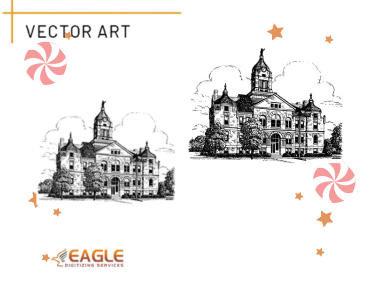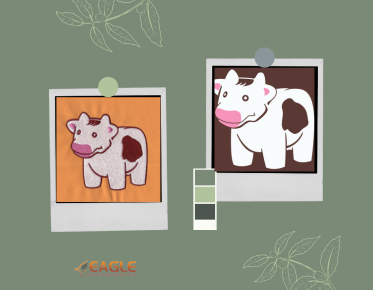Clearing Up Common Misconceptions About Vector Art
Vectorart
often sparks confusion, surrounded by myths and misunderstandings that cloud
its true potential. While some see it as the domain of expert graphic
designers, others mistakenly believe it’s all about simple shapes and flat
images. The complexity of vector art is often underestimated, and in reality,
it has far more to offer. In this guide, we’ll clear up the most common
misconceptions, shedding light on the flexibility, accessibility, and diverse
possibilities that vector art holds.
Myth: Vector Art is Only for Professionals
One
of the most prevalent myths about vector art is that it’s reserved solely for
seasoned professionals with advanced design skills. The truth, however, is that
vector art is beginner-friendly and accessible to anyone willing to dive in.
Thanks to intuitive software and online tutorials, newcomers can easily grasp
the basics and start creating stunning designs. Modern tools like Inkscape and
Vectr offer user-friendly interfaces, allowing both hobbyists and professionals
to bring their visions to life. The learning curve isn't as steep as many
believe, and with a little practice, anyone can master the art of vectors.
Myth: Vector Art Always Looks Basic and Cartoonish
Vector art is
often reduced to simple, flat illustrations that look cartoonish or overly
minimal. But this couldn’t be further from the truth. The medium is incredibly
versatile, spanning a vast range of styles from simple icons to intricate,
lifelike renderings. Complex vector illustrations,
such as highly detailed portraits or elaborate landscapes, can rival the
realism of traditional mediums. Artists like Lora Zombie and Charis Tsevis have
pushed vector art into the realm of hyper-realism, proving that vectors can go
far beyond basic designs.
Myth: Vector and Raster Art are the Same Thing
Another
misconception is that vector and raster art are interchangeable. While both are
essential in digital design, they are fundamentally different. Raster art is
pixel-based, meaning its resolution can degrade as it’s scaled, causing images
to appear blurry or pixelated. Vector art, on the other hand, is based on
mathematical equations that allow it to be resized infinitely without losing
any quality. This makes vectors ideal for everything from logos to large-format
prints. Understanding when to use each type of art is crucial for achieving the
best results in your projects.
Myth: Vector Art Loses Quality When Scaled
One
of vector art’s greatest advantages is its scalability. Unlike raster images
that become blurry or pixelated when enlarged, vectors remain crisp at any
size. This makes vector graphics ideal for everything from tiny icons on a
website to massive billboards on city streets. Whether you’re creating a logo
for a business card or designing a sprawling mural, vector art will retain its
sharpness and detail—something raster art simply can't match in such a range of
sizes.
Myth: Vectors Are Just For Logos and Icons
Although vector
art is synonymous with logos and icons, its applications go far beyond these
basic designs. From posters and advertisements to merchandise, illustrations,
and animations, vector art plays a key role in a wide array of creative fields.
It’s also used in web design, animation, fashion, and even architectural
drawings. The adaptability of vector files makes them a powerful tool for
virtually any creative project that requires scalable, high-quality graphics.
Myth: You Need Expensive Software for Vector Art
It’s a common
belief that you need high-end, expensive software like Adobe Illustrator to
create vector art. While Illustrator is undoubtedly a powerful tool, there are
plenty of free or budget-friendly alternatives that offer similar features.
Inkscape, Vectr, and Gravit Designer provide all the essential vector tools you
need to get started, without the hefty price tag. These programs have made vector design more accessible than ever, allowing
hobbyists and small businesses to create professional-quality artwork without
breaking the bank.
Myth: Vector Files Are Always Small
While vector
files tend to be smaller than raster images, they can still become hefty under
certain circumstances. The size of a vector file is determined by the
complexity of the design—more intricate details, complex paths, or excessive
layering can all contribute to larger file sizes. However, compared to raster
files, which increase in size as the resolution rises, vector
files remain much more manageable in terms of storage space, even for
highly detailed designs.
Myth: Vectors Can’t Have Texture and Depth
One misconception
about vector art is that it’s flat and lacks the depth and texture seen in
other art forms. Vectors are incredibly versatile when it comes to adding
depth. Techniques like gradients, drop shadows, and even intricate textures can
be applied to create a more dynamic, three-dimensional appearance. Artists
often use these methods to add nuance and detail, giving vector art a lifelike
quality that extends beyond the typical flat shapes and colors.
Myth: Vector Art is Flat and Boring
Vector art has
evolved significantly from its humble beginnings. Modern techniques and
advancements in software have led to the rise of 3D vector art, bringing a
whole new level of depth and excitement. By using layers, perspective, and
shadowing, artists can add a sense of dimension and realism that was once
thought impossible within the realm of vectors. With 3D elements becoming more
popular, vector art is anything but flat and boring—it’s a dynamic, engaging
medium that continues to push boundaries.
Myth: Vector Art Can’t Be Photorealistic
Another myth is
that vector art is incapable of producing photorealistic images. In reality,
many talented artists specialize in creating hyper-realistic vector artwork
that mimics the intricacies and textures of real-life subjects. Through
meticulous pathing, shading, and gradient work, these artists can achieve
remarkable photorealism with vector tools. Achieving photorealism in vector art
requires patience, precision, and an understanding of how to replicate subtle
light effects, textures, and shading—all of which are entirely possible within
the vector medium.
Myth: You Can’t Print Vector Art Properly
Vector art is one
of the best formats for printing. The scalability of vectorgraphics ensures that they maintain high quality even when printed in
large formats. Whether it’s a business card, poster, or a huge billboard,
vector files can be resized without losing resolution. In addition, the clean,
crisp lines that vectors produce make them perfect for printing detailed logos,
illustrations, and text. When preparing a vector file for print, it’s essential
to choose the correct resolution and ensure color profiles are accurate for the
best results.
Myth: Only Graphic Designers Use Vector Art
Vector art isn’t
just for professional graphic designers—it’s useful for a variety of creative
and business-oriented fields. Marketers, web developers, content creators, and
even entrepreneurs can benefit from understanding vector art. For instance, web
developers use vector graphics to ensure fast, responsive websites, while
marketers rely on vectors for creating scalable and versatile logos,
infographics, and promotional materials. The ability to manipulate vectors
opens up a wealth of opportunities for anyone involved in the creative or
digital sectors.
Myth: Vectors Can’t Have Gradients and Color Transitions
While vector art
is often associated with solid colors and simple shapes, it can also
accommodate complex gradients and color transitions. Mastering gradients in
vector art adds dimension, blending smooth color transitions that can enhance
the overall look of your design. Whether you’re creating a soft gradient
background or applying color transitions to objects, vectors can seamlessly
integrate these features without sacrificing quality.
Myth: Vector Art Takes Too Long to Make
Many believe that
creating vector art is a time-consuming process, but with the right tools and
techniques, it can actually be quite efficient. Advanced software often
includes shortcuts, pre-set patterns, and easy-to-manipulate templates that
allow designers to speed up their workflow. With some practice, you can create
complex designs in a fraction of the time it might take with other mediums.
Myth: Vector Art is Only for Digital Use
Vector art is not
confined to digital screens; it is highly versatile and can be used in a
variety of mediums, from print to physical products. Whether it's fabric
printing, merchandise design, or packaging, vector art’s scalability and
flexibility make it an ideal choice for all sorts of applications. Its
adaptability allows it to be used for everything from t-shirts and posters to
promotional products and large-scale displays.
Myth: You Can’t Edit Vector Art Easily
Many think that
editing vector art is a complex and daunting task. However, once you understand
the basics of paths, nodes, and layers, editing becomes a simple and intuitive
process. Adjusting shapes, changing colors, or fine-tuning details can be done
in a matter of clicks. Vector software allows you to edit your designs without
the risk of losing quality, making it easy to revise and perfect your work.
Myth: Vectors Aren’t as Detailed as Rasters
Vector art is
often thought to be limited in terms of detail, but in reality, vectors can
handle incredibly intricate designs. With the ability to work with paths and
curves, vector art can contain layers of fine detail that rival raster images.
Complex illustrations, fine line work, and intricate patterns can all be
created in vector form, allowing artists to achieve an exceptional level of
detail.
Myth: Vector Art Isn’t Responsive for Web
Thanks to SVG
(Scalable Vector Graphics) files, vector art is the perfect solution for
responsive web design. SVG files adjust seamlessly to different screen sizes
and resolutions, ensuring that your vector designs appear sharp and crisp on
any device. This adaptability is why vectors are a staple in modern web
development, offering a fast, efficient, and scalable option for web graphics.
Myth: Vector Art is Only for Static Images
Vector art is not
confined to static images; it can also be used in animation. With tools like
Adobe Animate and After Effects, vector art can be brought to life through
motion. This flexibility allows for the creation of dynamic, animated graphics
that are smooth, clean, and crisp, perfect for everything from website
animations to explainer videos.
While many misconceptions cloud the true potential of vector art the reality is that this medium is incredibly versatile, accessible, and powerful. Whether you’re creating logos, illustrations, animations, or print designs, vectors provide a scalable and high-quality solution. By debunking the myths and understanding the flexibility of vector art, you’ll be empowered to explore its full range of creative possibilities.


.png)
